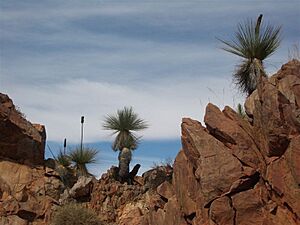Yudnamutana, South Australia facts for kids
Quick facts for kids YudnamutanaSouth Australia |
|
|---|---|

Copper smelters of Yudnamutana in 1910
|
|
| Established | 1862-1865 and 1903-1912 |
| Location | |

Yudnamutana is a historic valley in the northern Flinders Ranges in South Australia. It's known for its old copper mines. You can find it near Mount Freeling, northwest of Arkaroola. This area is part of a wilderness sanctuary. You usually need a four-wheel drive vehicle to get there.
Today, the old mining sites offer a chance for bush camping. However, there are no shops or supplies available. If you walk across the mountain tops, you can see amazing views. You can look out over the Flinders Ranges and into the wide plains of the outback. In the northern part of the valley, you can find black rocks called magnetite.
Contents
History of Yudnamutana
First People of the Land
For thousands of years, the Adnyamathanha tribe lived in this area. They are an Indigenous Australian group. These people were Stone Age hunter-gatherers. This means they found their food by hunting animals and gathering plants. They lived across a large part of the land to the south of Yudnamutana.
European Settlers Arrive
In the 1850s, European farmers, called pastoralists, first settled in this area. Soon after, people looking for valuable minerals, called prospectors, arrived. They hoped to find a large mineral deposit, like the famous one found in Burra.
Copper Mining at Yudnamutana
Finding Copper
In 1859, two men named A. Frost and H. Gleeson discovered copper here. Yudnamutana quickly became a site for an early South Australia copper mine. Mining started in 1862. It became famous in Adelaide when a huge piece of copper ore, weighing about 4 tons, was shown off in the streets.
Challenges of Early Mining
Getting the copper to market was very hard. Workers had to haul the heavy copper to Port Augusta. They used animal-drawn carts called drays. The journey was about 300 kilometers (186 miles) long over rough tracks. This made it very expensive and difficult for the mining company to make money. In 1869, a severe drought hit the area. There wasn't enough water for the animals working at the mine, so it had to close down.
A New Start and New Problems
Mining began again at Yudnamutana in the early 1900s. This time, transport was a bit easier. The copper was hauled by dray for about 100 kilometers (62 miles) to Farina. From there, it could be sent by train on the Central Australia Railway.
To save even more money on transport, the mine owners tried something new in 1909. They started using a special type of road train to carry the copper to the Farina railway station. However, the land was too rough, and the machines often broke down. This plan did not last long.
A small smelter, which is a place to melt ore, was built in Farina around 1909 or 1910. But it was only used for a few tests and closed soon after. It was taken down completely in 1938. The mine itself closed again by 1912.
What Remains Today
Today, all that is left of the old Yudnamutana settlement are a few things. You can still see two large boilers, some old mine shafts, and some dugouts (shelters dug into the ground). There is also a cemetery from the mining days.


